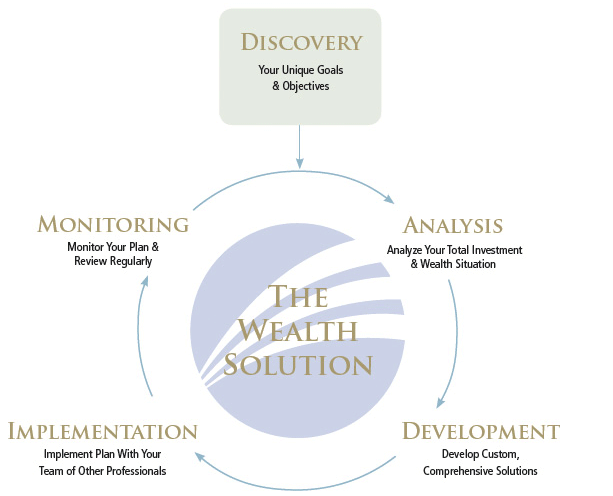Personalized Investment Management
How Elevation Wealth Partners assists investors with Personalized Investment Management
At Elevation Wealth Partners, we appreciate that every client is unique. For that reason, we’ll customize your portfolio to fit your individual financial goals and create investment allocations tailored to maximize your chances of achieving them. Our recommendations include a blend of investments and tax-efficient strategies designed for long-term growth and short-term stability. As your life changes, we will continually review and adjust your portfolio to ensure it remains aligned with your evolving objectives.

Our 5 Step Process
Discovery
During our discovery process, we focus on what is most important to you, both financially and personally. Together, we will define what financial success means to you and translate this into prioritized goals.
Analysis
Development
Based on the analysis, we will develop a long-term wealth plan to get you from today to where you want to be. Throughout this process, we will address any items that need clarification and adjust based on new or additional information.
Implementation
The next step is the implementation of your plan. In addition to creating your investment portfolio, we also work with a team of financial professionals to address the non-investment action items we’ve identified. You will receive an Investment Policy Statement which documents our findings and agreement, assigning responsibly and accountability.
Monitoring
How we invest and what we look for
Stocks: Also referred to as equities, stocks are considered a purchase of ownership in, and in turn, a share of a company. Since future cash flows and profits are uncertain, over the long term, stocks are expected to deliver higher returns than fixed income, though they come with greater short-term volatility.
- U.S. Stocks: This portion includes a mix of large and small U.S. stocks, usually low cost mutual funds and ETFs (exchange traded funds), aiming to balance various investment styles and company sizes. Small stocks may offer higher returns but with more volatility.
- Foreign Stocks: Investing outside the U.S. helps diversify your portfolio, offering long-term growth, inflation protection, and reduced overall volatility. Developed markets, primarily in Europe and Asia, generally have lower risk and returns compared to emerging markets.
Bonds: Also called fixed income, bonds can be considered loans to governments or a company in exchange for interest payments or additional income. Bonds add stability and offer some protection against severe economic conditions. Short-term bonds are less volatile but offer lower returns, while high-yield bonds carry more risk but higher rates. Tax-free municipal bonds offer tax-exempt income, though only some are exempt from the Alternative Minimum Tax (AMT). Depending on the needs of the client, we’ll invest in bond funds or purchase individual bonds.
Alternative Investments, Real Estate, and Real Assets: These investments aim to reduce portfolio volatility and provide returns not correlated with traditional markets. They include public and private real estate, commodities, and infrastructure. Real assets add diversification, current income, and inflation protection but can be either liquid or illiquid.
Manager Selection: We choose managers who use diversified, long-term, low-turnover, low-fee strategies. Our evaluation focuses on:
- Process & Performance: We look at the manager’s investment philosophy, strategy, and performance consistency.
- People: We prefer experienced managers with significant personal investment and those from reputable, investor-focused firms.
Price: We seek funds that offer good value with low fees and trading costs.
Frequency of Review: Investments go through cycles, and patience is essential. We aim for long-term performance goals, typically over five years.

The Five Pillars of our Investment Philosophy
Markets are highly efficient
Risk and expected return are related
Diversification is essential
Pursue factors of returns
Focus on what you can control
Don’t try to predict interest rates, anticipate the impact of government actions or outsmart other traders. Instead, focus on the areas that can be controlled—such as setting a thoughtful investment strategy and following a disciplined review process.
